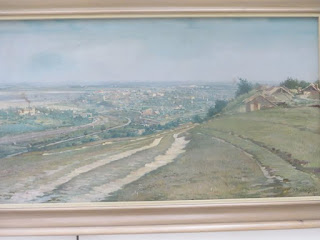Those
wanting a sense of how the events of the last century have impacted on the soul
of one Balkan country have a unique opportunity in Sofia these next few weeks.
Three exhibitions in Sofia offer samples, first, of the paintings of Bulgarians
who had the opportunity to study in France in the half-century before the
communist takeover of 1944. By definition, those able to avail themselves of
such opportunities came from richer families and were therefore often targeted
in the immediate aftermath of that takeover.
They included figures such as Nikola Tanev, Tseno Todorov and Constantin
Shterkelov. The National Gallery
exhibition runs until 30 May.
Sofia
City Gallery has an exhibition which some may think overdue called “Forms of
Resistance – 1944-1985” with exhibits selected and presented to give a sense of
how the world of Bulgarian (and central European) artists dramatically changed
as their countries slipped behind the Iron Curtain from 1944. The State
Security files (and prison drawings) of Alexander Bozhinov and Alexander
Dobrinov (leading caricaturists) and others are a powerful initial exhibit… as
are the 3 large industrial landscapes of one of Bulgaria’s greatest painters,
Nikola Tanev, produced after his release from almost a year in jail. The roll-call of imprisoned or disgraced painters covers Bulgaria's main artistic names - and must have had a devastating effect on the creative spirit......
The
gallery has produced an excellent video – with the paintings shown from the 4th
minute
I
first realized the scale of the veil which has been drawn over this subject a
few years ago when I was compiling an annotated list of 140 Bulgarian painters
for my first booklet…. "Bulgarian
Realists – getting to know the Bulgarians through their art". The caricaturist Rayko Alexiev had died in his first
weeks in prison and the superb landscape artist Boris Denev was basically was banned for life but, slowly,
the internet revealed (with help from google translate!) scraps of information
which are not offered in the various catalogues and monographs which the
Bulgarian galleries publish.
The
Bulgarians, it appears, do not like to discuss this period…..there are still
too many skeletons… the belated attempts at official
investigations have been half-hearted – as one woiuld expect when its main
political party (BSP) is effectively the old communist party….
The
(bi-lingual) text which accompanies the City Gallery’s current exhibition is,
therefore, for me the first detailed explanation of what exactly happened to
artists in Bulgaria – both in the immediate aftermath and as communist power
consolidated and evaporated…..
Fascinating
to discover that, in the early weeks of the takeover (when the bodies of the
murdered political and government elite were still warm), 30 artists were
meeting to set up the first Union of Artists – and that Nikola Rainov emerged
as its president!
The
Zhendov
affair (of 1950) named some 30 deviant painters and led to the dismissal
from their academic jobs of painters of the caliber of Ivan Nenov and Kiril
Tsonev. Any hint of “mawkish naturalism” was pounced upon as an act of sabotage.
A hierarchy of accepted painting led with portrayals of political leaders
followed by glorification of labour and liberation. Landscapes were accepted
only if, like Tanev’s, they showed socialism in action….
As
the exhibition recognizes, artists responded in very different ways – some with
alacrity, others by turning to other activities, a few with various forms of
escape or rebellion….
Not
surprisingly in a part of the world in which recent history is strongly
disputed, the City Gallery exhibition – which runs until 26 May – has attracted
some controversy.
 The
final exhibition I want to mention is that of Bulgaria’s grand old man and
doyen of Bulgarian art - Svetlin Rusev who is still very active at the age of
83 and whose latest work is on display in the Seasons Gallery at Krakra St.
The
final exhibition I want to mention is that of Bulgaria’s grand old man and
doyen of Bulgarian art - Svetlin Rusev who is still very active at the age of
83 and whose latest work is on display in the Seasons Gallery at Krakra St.
Rusev
is a unique and towering figure - Chairman
(1973-85) of the Union of Bulgarian Artists but then fell out of favour with
the authorities for his rebellious activities. His position allowed him to build
up a
fantastic collection of art which he has donated to two public
galleries, one in Pleven, the other in Sofia at what used to be his studio
very near the Alexander Nevsky Church.
He
straddles both the communist and the modern period

 In the 80s he worked for a time at Bucharest’s famous Village Museum.... but his artistic
temperament was impatient with the discipline involved….
In the 80s he worked for a time at Bucharest’s famous Village Museum.... but his artistic
temperament was impatient with the discipline involved….












